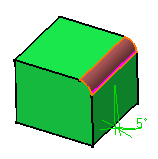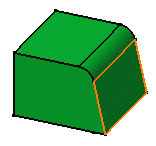


|
This task shows you how to
draft a face by using reflect lines as
neutral lines from which the resulting faces will be generated. In this
scenario, you will also trim the material to be created by defining a
parting element. |
| Open the
Draft3.CATPart document. |
-
Click Draft Reflect Line
 . .
The Draft Reflect Line Definition
dialog box is displayed and an arrow appears, indicating the default
pulling direction.
Pulling Direction
-
Select the cylinder.
The application detects one reflect line and displays it in pink.
This line is used to support the drafted faces.
|
The
 icon now available after the
Faces to draft field lets you edit the list of the faces to be
drafted. For more information about that capability, refer to
Editing a List of Elements. icon now available after the
Faces to draft field lets you edit the list of the faces to be
drafted. For more information about that capability, refer to
Editing a List of Elements. |
-
Enter an angle value in the Angle field. For
example, enter 11. The reflect line is moved accordingly.
-
Click Preview to get an idea of what the draft
will look like.
-
Click More>> to expand the dialog box.
Parting Element
-
Check the Define parting element option and
select plane zx as the parting element.
|
Contextual commands
creating the parting elements you need are available from the
Selection field:
- Create Plane: for more information, see
Creating Planes
- XY Plane: the XY plane of the current coordinate system
origin (0,0,0) becomes the parting element.
- YZ Plane: the YZ plane of the current coordinate system
origin (0,0,0) becomes the parting element.
- ZX Plane: the ZX plane of the current coordinate system
origin (0,0,0) becomes the parting element.
- Create Join: joins surfaces or curves. See
Joining
Surfaces or Curves.
- Create Extrapol: extrapolates surface boundaries or
curves. See
Extrapolating Surfaces and
Extrapolating Curves.
If you create any of these elements, the application then displays the
corresponding icon next to the Selection field. Clicking this
icon enables you to edit the element.
Limiting Elements
The Limiting Element(s) option limits
the face to be drafted by selecting one or more faces or planes that
intersect it completely. To know how to use this option, see Basic Draft.
Contextual commands creating the limiting
elements you need are available from the Limiting Element(s)
field:
- Create Plane: for more information, see
Creating Planes
- XY Plane: the XY plane of the current coordinate system
origin (0,0,0) becomes the limiting element.
- YZ Plane: the YZ plane of the current coordinate system
origin (0,0,0) becomes the limiting element.
- ZX Plane: the ZX plane of the current coordinate system
origin (0,0,0) becomes the limiting element.
If you create any of these elements, the application then displays the
corresponding icon next to the Limiting Element(s) field.
Clicking this icon enables you to edit the element.
-
Click OK to create the draft.
|
|
 |
Using the command described in this task, you can draft
faces after filleting edges, as illustrated in the example below: |
|
 |
 |
|
The application detects the reflect line on the selected
fillet. |
The face is drafted. |


![]()